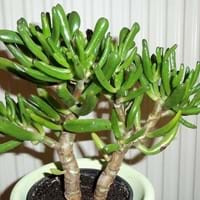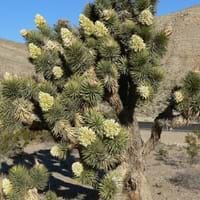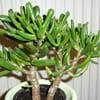Life Span
Perennial
Perennial
Type
Cactus or Succulent, Shrubs
Cactus or Succulent, Tree
Origin
Southern Africa, South Africa
Southwestern United States, Mexico
Types
Crassula portulaca,Crassula argentea
Not Available
Number of Varieties
Not Available
Habitat
Deciduous forests, Desert, Rocky Ridges, Semi desert
Desert, Dry areas, Rocky areas, Sandy areas
USDA Hardiness Zone
9-13
6-10
Sunset Zone
H1, H2, 8, 9, 12, 13, 14, 15, 16, 17, 18, 19, 20, 21, 22, 23, 24
9, 10, 11, 12, 13, 14, 15, 16, 18, 19, 20, 21, 22, 23
Habit
Oval or Rounded
Upright/Erect
Flower Color
White, Light Pink, Ivory
White, Ivory
Flower Color Modifier
Not Available
Not Available
Fruit Color
Not Available
Light Green
Leaf Color in Spring
Green, Olive, Dark Green
Gray Green, Dark Green
Leaf Color in Summer
Green, Olive, Dark Green
Gray Green, Dark Green
Leaf Color in Fall
Green, Olive, Dark Green
Gray Green, Dark Green
Leaf Color in Winter
Red, Olive, Dark Green, Bronze
Olive, Gray Green, Dark Green
Plant Season
Spring, Summer, Fall, Winter
Spring, Summer, Fall, Winter
Sunlight
Full Sun, Partial Sun
Full Sun
Growth Rate
Medium
Very Slow
Type of Soil
Loam, Sand
Loam, Sand
The pH of Soil
Neutral
Acidic, Neutral, Alkaline
Soil Drainage
Well drained
Well drained
Bloom Time
Early Spring, Spring, Early Winter, Winter, Late Winter
Early Spring, Spring, Late Winter
Tolerances
Drought
Drought
Where to Plant?
Container, Ground
Ground
How to Plant?
Budding, Leaf Cutting, Stem Planting
Leaf Cutting, Stem Cutting
Plant Maintenance
Medium
Medium
Watering Requirements
Allow soil to be completely dry in between waterings, Never Over-water
Allow soil to be completely dry in between waterings, Do not water frequently
In Summer
Moderate
Lots of watering
In Spring
Drought Tolerant, Average Water
Moderate
In Winter
Less Watering
Average Water
Soil pH
Neutral
Acidic, Neutral, Alkaline
Soil Type
Loam, Sand
Loam, Sand
Soil Drainage Capacity
Well drained
Well drained
Sun Exposure
Full Sun, Partial Sun
Full Sun
Pruning
Remove damaged leaves, Remove dead branches, Remove dead leaves
Remove damaged leaves, Remove dead branches, Remove dead leaves
Fertilizers
All-Purpose Liquid Fertilizer
All-Purpose Liquid Fertilizer, No fertilizers needed
Pests and Diseases
Red blotch
Brown Spots, Red blotch
Plant Tolerance
Drought
Drought, Dry Conditions, Dry soil, Heat Tolerance, Rocky Soil, Sun
Flower Petal Number
Single
Single
Foliage Texture
Bold
Bold
Foliage Sheen
Glossy
Matte
Attracts
Ants, Caterpillar
Not Available
Allergy
allergic conjunctivitis, Dizziness, Mouth itching, Vomiting
Not Available
Aesthetic Uses
Beautification, Bonsai, Cottage Garden
Decorating walls
Beauty Benefits
Acne, Making cosmetics, Natural Sunscreen, Nourishes scalp, Stops hair loss
Not Available
Environmental Uses
Provides ground cover, soil stabilisation
Air purification
Medicinal Uses
Acne, Antibacterial, Eczema, epilepsy, Gout, Laxative
Not Available
Part of Plant Used
Leaves, Sap, Stem
Not Available
Other Uses
Cosmetics, Used as Ornamental plant, Used for its medicinal properties
Not Available
Used As Indoor Plant
Sometimes
No
Used As Outdoor Plant
Yes
Yes
Garden Design
Container, Feature Plant, Foundation, Houseplant, Mixed Border, Rock Garden, Wall, Tropical
Feature Plant, Rock Garden, Wall
Botanical Name
CRASSULA ovata
YUCCA brevifolia
Common Name
Jade Money Plant
yucca palm
tree yucca
palm tree yucca
In Hindi
जेड पौधा
Joshua Tree
In German
Geldbaum
Joshua Tree
In French
Crassula ovata
Joshua Tree
In Spanish
Crassula ovata
Árbol de Joshua
In Greek
Crassula ovata
Joshua Tree
In Portuguese
Crassula ovata
Joshua Tree
In Polish
Grubosz jajowaty
Joshua Tree
In Latin
Crassula ovata
Joshua ligno
Phylum
Magnoliophyta
Tracheophyta
Class
Magnoliopsida
Magnoliopsida
Order
Rosales
Asparagales
Family
Crassulaceae
Agavaceae
Clade
Dicotyledonous
Angiosperms, Monocots
Tribe
Not Available
Not Available
Subfamily
Crassuloideae
Not Available
Importance of Jade Plant and Joshua Tree
Want to have the most appropriate plant for your garden? You might want to know the importance of Jade Plant and Joshua Tree. Basically, these two plants vary in many aspects. Compare Jade Plant and Joshua Tree as they differ in many characteristics such as their life, care, benefits, facts, etc. Every gardener must at least have the slightest clue about the plants he wants to plant in his garden. Compare their benefits, which differ in many ways like facts and uses. The medicinal use of Jade Plant is Acne, Antibacterial, Eczema, epilepsy, Gout and Laxative whereas of Joshua Tree is Not Available. Jade Plant has beauty benefits as follows: Acne, Making cosmetics, Natural Sunscreen, Nourishes scalp and Stops hair loss while Joshua Tree has beauty benefits as follows: Acne, Making cosmetics, Natural Sunscreen, Nourishes scalp and Stops hair loss.
Compare Facts of Jade Plant vs Joshua Tree
How to choose the best garden plant for your garden depending upon its facts? Here garden plant comparison will help you to solve this query. Compare the facts of Jade Plant vs Joshua Tree and know which one to choose. As garden plants have benefits and other uses, allergy is also a major drawback of plants for some people. Allergic reactions of Jade Plant are allergic conjunctivitis, Dizziness, Mouth itching and Vomiting whereas of Joshua Tree have Not Available respectively. Having a fruit bearing plant in your garden can be a plus point of your garden. Jade Plant has no showy fruits and Joshua Tree has showy fruits. Also Jade Plant is not flowering and Joshua Tree is not flowering . You can compare Jade Plant and Joshua Tree facts and facts of other plants too.





